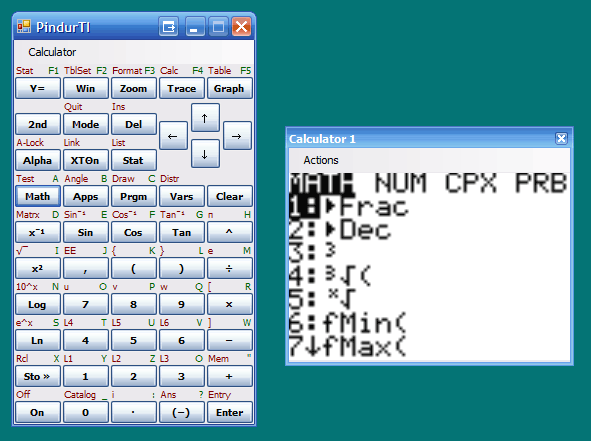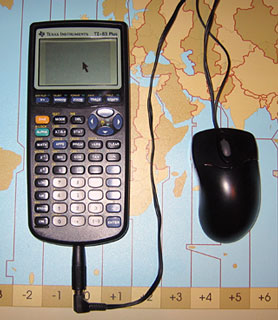TI-83 Plus Mouse
Tuesday, 21st February 2006
I had another go with my AT protocol routines to see if I could persuade a PS/2 mouse to do anything.
It would appear that I could...
There are two cables for the mouse as there were for the keyboard - one goes to the TI, the other goes to the power supply. The mouse is put into the lowest resolution mode (the cursor is moved 1 pixel per mm).
There's a demo for anyone with a TI-83 Plus and an adapter. It also contains a keyboard demo - and there's a video of that demo here (1MB WMV).
Fortunately, I didn't have to butcher that mouse (it's a rather good miniature USB/PS2 one), but it is connected to the TI with Blu-Tak to keep the wires on the contacts, and isn't very mobile as I only gave the power lead about 15cms clearance. I think it's high time I grabbed myself some proper connectors and a soldering iron from Maplin... ![]()
As for the mouse routines - they need a lot of tidying up and making much more reliable, especially in the recovery when a mouse is disconnected then reconnected (my keyboard routines are 'hot pluggable', after all). Extending them to support the Microsoft Intellimouse system, giving the mouse an extra axis (scroll wheel) and two extra buttons would be rather cool as well.
Ultimately, these routines are rather useless until they become widely adopted. Ideally, they could/would be added to a shell, and form part of the standard routines. For example, the shell could provide a "get key" function, which would also transparently return keyboard keys as if they were keys on the keypad, or return four "left" keys if the mouse was moved 4 mm left -- that sort of thing.
Chances of this happening are, sadly, nil. ![]()
Microhertz
Monday, 13th February 2006
They say that pictures are what make a journal interesting... but I don't really want to show the pretty pictures I have, as they'd spoil the surprise. Of what, you might ask? Well, I've been developing a TI-83/83+ scene demo, entitled "Microhertz" (for no particular reason). You can download it (and some screenshots, if you really must!) here.
Things have been very busy - a new Latenite beta, riddled with all new exciting "features" (*cough*), has been released... I'm slowly fixing them as and when I can ![]()
It's a bit rubbish for debugging - you can start, pause, and stop a debugging session, but that's about it. Hopefully it won't be too long until I get around to actually sorting out all the debugging gubbins, but I'd rather get the main IDE and the primitive debugging more stable first.
One other TI project I'm working on is updating QuadPlayer. I have a 1.1 version which can play songs from the archive as well as RAM, has a loop function and other little fixes and tweaks. To complement it, I've written a simpler script for creating your own songs, a better Windows-based player for testing (which simulates QuadPlayer's internal sound generation system and has accurate timing) and (best of all) am working on a program that takes PSG VGM files (BBC Micro, Sega Master System &c) and converts them to QuadPlayer songs. So far, any songs that do "exciting" things - vibrato, for example - end up sounding horrible in high octaves (I'm having to limit 10-bit to 8-bit periods), but I have some very decent sounding QuadPlayer files based on Sega VGMs. Some songs use lots of short, fast notes - which sounds great on dedicated hardware, but when you have a delay as QuadPlayer stops outputting a square wave to fetch the next note, sounds crap.
YM2413 (OPLL) Emulation
Monday, 30th January 2006
As (yet another) side project to all this Z80 work, I've also decided to have a stab at the Japanese Master System's FM chip. It's a YM2413, and the documentation on it is fairly tricky to get to grips with - not only thanks to it being in typical Japanese-manual English.
So far, I have this - the VGM player is a bit buggy and extremely primitive (unfinished), but should be enough to demonstrate the current state of the OPLL. You'll need an FM VGM to try it with - the Space Harrier demo from the BIOS sounds pretty good.
If anybody has had any experience with the YM2413, I'd be interested to hear if you had any helpful tips...
In other news, I've been adding multipage program support to Brass, and Latenite has had a lot of debugger integration work done on it. It's still a long slog before it's in a presentable state, sadly.
Debugging...
Thursday, 12th January 2006

CoBB has added an non-interactive mode to his emulator. I'd never thought about using stdin/stdout to pass information between executables; but it works well (once I've ironed out the bugs at my end, that is!) All I need to do is pass it instructions via stdin then read back the results (such as a screen dump) through stdout. This can then be, hopefully, used to pass instructions back to Latenite ("Highlight line 43 on file source.asm", for example, to show where the PC is).
TI Z80 Development Gets Cool
Tuesday, 10th January 2006
This excites me greatly - integrating a debugging emulator into Latenite is very, very awesome. CoBB's emulator is incredibly good as a standalone, being able to step through your code instruction-by-instruction with breakpoints and a watch window or two is just amazing! ![]()
I spent most of the last few days working on Brass - adding for loops to assemble blocks of code multiple times and a few file operations for people not happy with the behaviour of .incbin. I also remembered to release an XML help file for Latenite.
The Marble Madness engine project has been plodding along in the background - I've written a fast masked, clipped, 16x16 sprite routine and have started tackling the big problem of mapping the ball's 3D coordinates to the screen (easy) and then to a heightmap (hard) for Physics.

Have a marble rolling off a ledge then bouncing off the right screen boundary. ![]()
